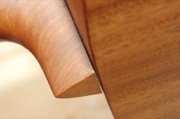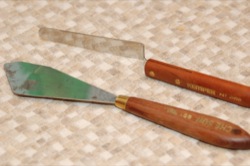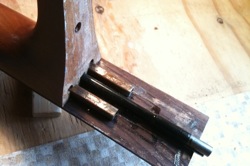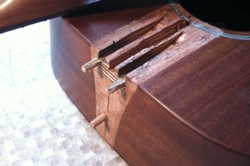Guitar Repair: Acoustic Neck Break (Neck Removal)
 In a previous post, I gave my opinion on what I saw as the problems with the neck-joint design of a guitar I’d recently worked on. I thought you might be interested in some more detail about that repair (without my whinging about design issues). While some of the steps undertaken in this repair are common with any job that involves removing a guitar’s neck, you might find it useful to, first, check out some of the ways in which this guitar differed.
In a previous post, I gave my opinion on what I saw as the problems with the neck-joint design of a guitar I’d recently worked on. I thought you might be interested in some more detail about that repair (without my whinging about design issues). While some of the steps undertaken in this repair are common with any job that involves removing a guitar’s neck, you might find it useful to, first, check out some of the ways in which this guitar differed.
The guitar had taken a knock and its neck had become detached at the heel. It still appeared to have some attachment towards the guitar top but it wasn’t easy to see what was going on. Internally, there was quite a small neck block—too small to accommodate a dovetail—and no sign of bolts although the feeler gauge I inserted seemed to indicate something bolt like. It actually took a chat with the manufacturer’s customer service to sort it out. There were no bolts or dovetails—dowels were used to align the neck and the joint was a mortice and tenon.
Fixing a problem like this on a guitar isn’t just a matter of squirting some more glue in and hoping for the best. A proper job requires that the joint be disassembled and cleaned. If this isn’t done, the new glue will not penetrate properly and will only adhere to the older, failed glue rather than to good, strong wood.


Removing an acoustic guitar neck involves softening whatever glue is holding the neck to the body. A dovetail requires holes be drilled into the joint so that the glue can be softened by carefully injecting steam. That’s not required for a bolt-on neck, of course, but what is common with all joints—including this one— is that the glue holding the fingerboard extension to the guitar’s top be loosened. We do this by applying heat.
Sometimes that heat is applied using a cast block that I heat on a hotplate. For some jobs though, I use heating blankets. These are much more controllable but you still need to take care. The blanket is clamped—loosely—to the fingerboard extension and I keep a very close eye on it. When I judge that heat has penetrated the board and begun to soften the glue I remove the blanket and get to work with the palette knives. It’s a delicate job as too much pressure could easily tear into, or lift grain from, the guitar top underneath. It’s often necessary to heat the area a couple of times to separate the surfaces.
Once the fingerboard extension is loose, the neck removal can begin. As I mentioned, on a bolt-on this is an simple as undoing some bolts while a dovetail would need the joint steamed loose. On this neck, removal was complicated because of the construction.


You can see from the images that the neck has two steel box-sections protruding from the heel. These were glued into the corresoponding channels in the guitar top. I needed to get this glue to soften too but the heating blanket wasn’t going to do the trick. It was necessary to use a similar technique to that used for dovetail disassembly. I removed one of the frets on the extension, drilled a couple of small access holes and injected steam (very carefully—these are small channels very close to the guitar top).
This process, too, was made more difficult than on a traditional construction. Because of the alignment pins, I could not remove the neck from the body vertically. Instead, I needed to ‘pull’ the neck away from the side. It made for an annoying job as it’s really hard to get any leverage or apply pressure well.
—o—
As this is becoming a little long, I’ll cover reassembly in a future post. Oh, the suspense…
This article was brought to you by Gerry Hayes from the workshop of Haze Guitars and is cross-posted there. Haze Guitars provides guitar repair, restoration and upgrade services and makes beautiful, hand-built instruments

